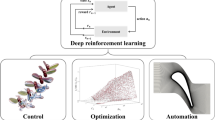Abstract
Nowadays the rapidly developing artificial intelligence has become a key solution for problems of diverse disciplines, especially those involving big data. Successes in these areas also attract researchers from the community of fluid mechanics, especially in the field of active flow control (AFC). This article surveys recent successful applications of machine learning in AFC, highlights general ideas, and aims at offering a basic outline for those who are interested in this specific topic. In this short review, we focus on two methodologies, i.e., genetic programming (GP) and deep reinforcement learning (DRL), both having been proven effective, efficient, and robust in certain AFC problems, and outline some future prospects that might shed some light for relevant studies.
Similar content being viewed by others
References
Cai S., Zhou S., Xu C. et al. Dense motion estimation of particle images via a convolutional neural network [J]. Experiments in Fluids, 2019, 60: 73.
Duraisamy K., Iaccarino G., Xiao H. Turbulence modeling in the age of data [J]. Annual Review of Fluid Mechanics, 2019, 51: 357–377.
Huang J., Liu H., Cai W. Online in situ prediction of 3-D flame evolution from its history 2-D projections via deep learning [J]. Journal of Fluid Mechanics, 2019, 875: R2.
Wang Q., Hesthaven J. S., Ray D. Non-intrusive reduced order modeling of unsteady flows using artificial neural networks with application to a combustion problem [J]. Journal of Computational Physics, 2019, 384: 289–307.
Wu H., Liu X., An W. et al. A deep learning approach for efficiently and accurately evaluating the flow field of supercritical airfoils [J]. Computers and Fluids, 2020, 198: 104393.
Koza J. R. Genetic programming: On the programming of computers by means of natural selection [M]. Cambirdge, USA: MIT Press, 1992.
Goldberg D. E., Holland J. H., Genetic algorithms and machine learning [J]. Machine Learning, 1988, 3: 95–99.
Ren F., Wang C., Tang H. Active control of vortex-induced vibration of a circular cylinder using machine learning [J]. Physics of Fluids, 2019, 31: 093601.
Zhang W., Li X., Ye Z. et al. Mechanism of frequency lock-in in vortex-induced vibrations at low Reynolds numbers [J]. Journal of Fluid Mechanics, 2015, 783: 72–102.
Gautier N., Aider J. L., Duriez T. et al. Closed-loop separation control using machine learning [J]. Journal of Fluid Mechanics, 2015, 770: 442–457.
Debien A., von Krbek K., Mazellier N. et al. Closed-loop separation control over a sharp edge ramp using genetic programming [J]. Experiments in Fluids, 2016, 57: 40.
Parezanovic V., Laurentie J. C., Fourment C. et al. Mixing layer manipulation experiment from open-loop forcing to closed-loop machine learning control [J]. Flow Turbulence and Combustion, 2015, 94: 155–173.
Parezanovic V., Cordier L., Spohn A. et al. Frequency selection by feedback control in a turbulent shear flow [J]. Journal of Fluid Mechanics, 2016, 797: 247–283.
Li R., Noack B. R., Cordier L. et al. Drag reduction of a car model by linear genetic programming control [J]. Experiments in Fluids, 2017, 58: 103.
Wu Z., Fan D., Zhou Y. et al. Jet mixing optimization using machine learning control [J]. Experiments in Fluids, 2018, 59: 131.
Fan D., Zhou Y., Noack B. R. Artificial intelligence control of a turbulent jet [C]. 21st Australian Fluid Mechanics Conference, Adelaide, Australia, 2018.
Heess N., Sriram S., Lemmon J. et al. Emergence of locomotion behaviours in rich environments [EB/OL]. arXiv preprint, 2017, arxiv:1707.02286.
Schulman J., Wolski F., Dhariwal P. et al. Proximal policy optimization algorithms [EB/OL]. arXiv preprint, 2017, arxiv:1707.06347.
Rabault J., Kuchta M., Jensen A. et al. Artificial neural networks trained through deep reinforcement learning discover control strategies for active flow control [J]. Journal of Fluid Mechanics, 2019, 865: 281–302.
Rabault J., Kuhnle A. Accelerating deep reinforcement learning strategies of flow control through a multienvironment approach [J]. Physics of Fluids, 2019, 31: 094105.
Ren F., Tang H. Active flow control of flow past a circular cylinder at moderate Reynolds number using deep reinforcement learning [C]. International Symposium on High-Fidelity Computational Methods and Applications, Shanghai, China, 2019, 141.
Reddy G., Celani A., Sejnowski T. J. et al. Learning to soar in turbulent environments [J]. Proceedings of the National Academy of Sciences of the United States of America, 2016, 113(33): 4877–4884.
Verma S., Novati G., Koumoutsakos P. Efficient collective swimming by harnessing vortices through deep reinforcement learning [J]. Proceedings of the National Academy of Sciences of the United States of America, 2018, 115(23): 5849–5854.
Colabrese S., Gustavsson K., Celani A. et al. Flow navigation by smart microswimmers via reinforcement learning [J]. Physical Review Letters, 2017, 118: 158004.
Ho J., Ermon S. Generative adversarial imitation learning [EB/OL]. arXiv preprint, 2016, arXiv:1606.03476.
Acknowledgements
This work was support by the Research Grants Council of Hong Kong under General Research Fund (Grant Nos. 15249316, 15214418), the Departmental General Research Fund (Grant No. G-YBXQ).
Author information
Authors and Affiliations
Corresponding author
Rights and permissions
About this article
Cite this article
Ren, F., Hu, Hb. & Tang, H. Active flow control using machine learning: A brief review. J Hydrodyn 32, 247–253 (2020). https://doi.org/10.1007/s42241-020-0026-0
Received:
Revised:
Accepted:
Published:
Issue Date:
DOI: https://doi.org/10.1007/s42241-020-0026-0




